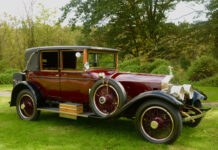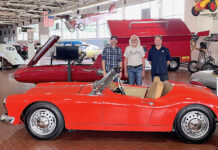By Jay Hirsch
Founded in 1909 by Roy D Chapin with the financial backing of the Detroit J.L. Hudson department store, Hudson was known as a medium-priced range car with high-price caliber.
By the late 1930s/early 1940s the company not only produced passenger cars, but also a woody station wagon, a convertible (not all cars had a convertible in their line of cars), and a pickup based on the standard Hudson body. Hudson made their first pickup in 1929. As with that first pickup, the front part of the 1947 pickup truck was based on the Hudson sedan, minus the rear passenger quarter. The nose and fenders were basic 1947 Hudson with a much beefed-up undercarriage and sturdy bed for carrying cargo behind the driver.
The cab part of this truck is extremely comfortable and passenger like, since it is based on the passenger vehicle. Most pickups or small cargo trucks of the time had interiors for which the word “Spartan” would be an understatement. The words “truck” and “comfort” wouldn’t be a combined as a concept for about another 10 to 20 years., the 1957 Ford Ranchero being the first vehicle to combine a pickup bed with the front of a passenger car.
But Hudson did not see things as such and this fine example of one of the last pickups to be made by Hudson demonstrates that. The Hudson had a sedan-like bench seat, radio, heater/defroster — all creature comforts that were still not common on some lower-end cars of the period. Until the early 1950s heaters/defrosters were not a common sight on all cars. A radio? And in a truck? Hudson had these. The Hudson had a 128-inch wheelbase, was 214 inches long, 68.75 inches tall and was powered with an inline 308 cid/5 liter engine, and rode on 6.50 x 16 tires.
Breaking with another tradition of the period, this Hudson has an eight-foot-long bed. Almost all small truck/pickups had six foot beds, which with the wheel well protruding into the bed cut down on cargo carrying capacity.
The hood on the Hudson is a tilt hood. That is, it tilts forward, rather than have the hinges near the firewall to tilt rearward. This was not done just to stand out whether parked at a service area or just to look different. There was a safety factor going on here. Until the 1950s many of the items on a car or truck taken for granted today were not so prior to 1950. Hood locks/catches were one of these. More than one driver of this era had the harrowing experience of going down a highway and suddenly have the hood of the car come undone and blow backwards off the car. The terms “safety latch” or “child-proof door lock” were just coming into the car vocabulary in the early 1950s.
When automobile manufacturers started to write in their advertising copy about safety latches on doors this also doubled for hoods. By the end of the 1950s these safety features were on all vehicles no longer appeared in car or truck advertising. As for hauling cargo, rough roads, mud and snow this was no problem for the Hudson. With its low gear and axle ratio, the initial spin of the wheels was slow, which gave tremendous traction and pulling power. It is the initial starting out or pulling out where traction is most crucial, especially while hauling cargo or under adverse road conditions. Four-wheel drive was not even thought of in this Hudson or most utility vehicles prior to the mid-1950s. Most people who owned or still own a Jeep made in the late 1940s and 1950s hardly ever used their four-wheel drive. The axle ratio took care of most of their needs 90 per cent of the time.
Depending on the gear ratio on the Hudson, you could walk along the pickup and throw baled hay into it as the Hudson strayed in the rutted out part of the dirt road. This was possible with most pickups of the 1920s through early 1950s when a majority of pickups were used for farm use. There were aftermarket locks, which were usually just a long cylinder that you placed on the steering wheel. These locks held the wheel steady when the dirt road was level and had no ruts.
In 1955 Hudson and Nash merged to become American Motors. The Hudsons were basically a Nash with different grills and the bigger V-8 engine. The last year for Hudson and Nash was 1957. American Motors devoted all its energy towards the Rambler, which was the first American compact car which was about 20 years ahead of it time.
Dick Zuidema, the owner of this 1947 Hudson, also owns a few other Hudsons and AMC cars. Dick and his father had a particular fondness for Hudsons and AMC cars. His family had a Hudson dealership and when Hudson and Nash merged to become American Motors. It morphed into a Jeep dealer in the 1980s. •



